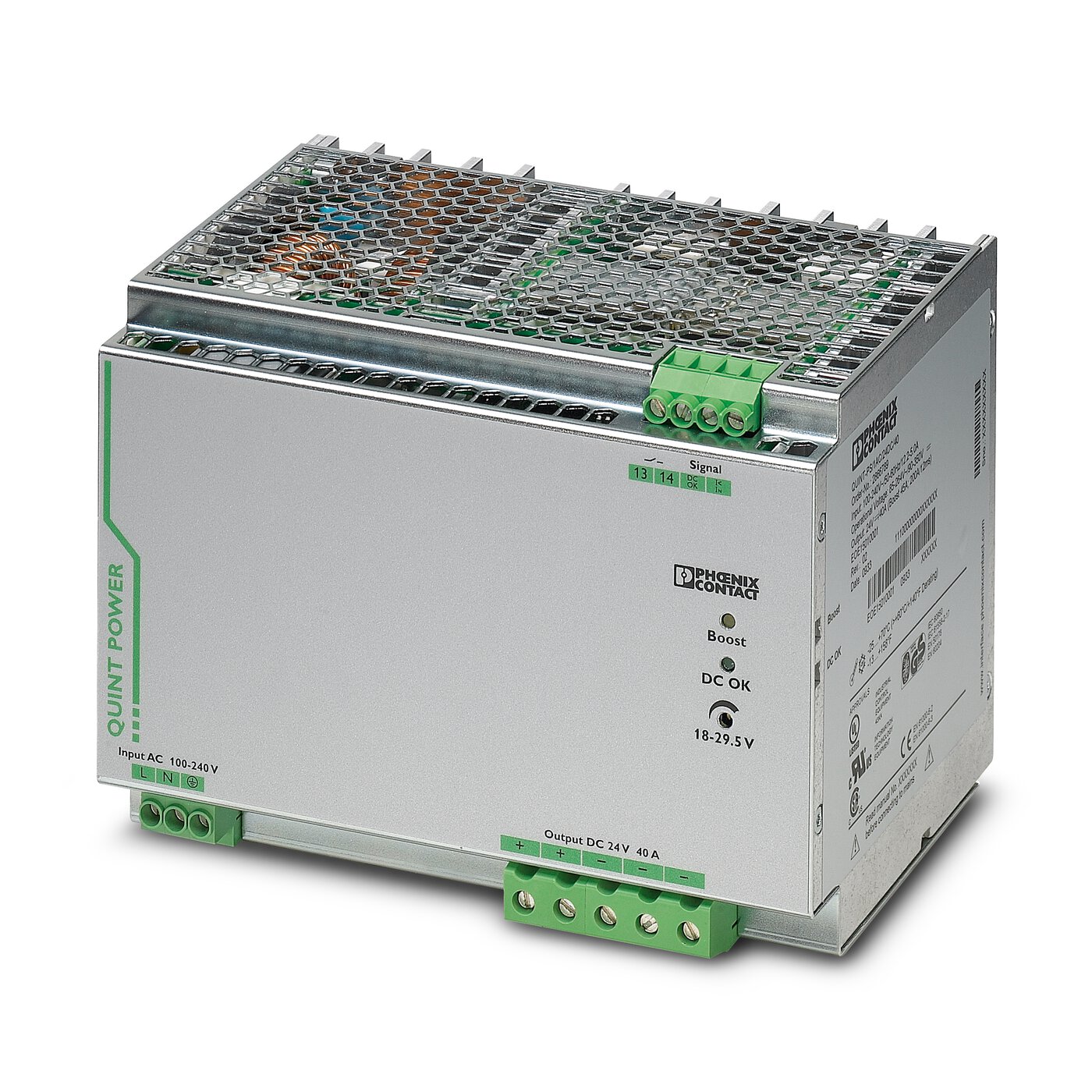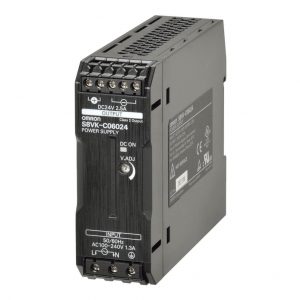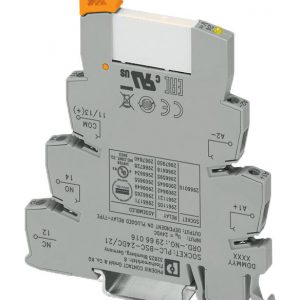توضیحات
Power supply unit – QUINT-PS/1AC/24DC/40
Primary-switched power supply unit, QUINT POWER, Screw connection, DIN rail mounting, SFB Technology (Selective Fuse Breaking), input: 1-phase, output: 24 V DC / 40 A
QUINT POWER power supplies with maximum functionality
QUINT POWER circuit breakers magnetically and therefore quickly trip at six times the nominal current, for selective and therefore cost-effective system protection. The high level of system availability is additionally ensured, thanks to preventive function monitoring, as it reports critical operating states before errors occur.
Reliable starting of heavy loads takes place via the static power reserve POWER BOOST. Thanks to the adjustable voltage, all ranges between 5 V DC … 56 V DC are covered.
| AC operation | |
| Nominal input voltage range | 100 V AC … 240 V AC |
| 120 V DC … 300 V DC (UL 508: ≤ 250 V DC) | |
| Input voltage range | 85 V AC … 264 V AC |
| 90 V DC … 300 V DC (UL 508: ≤ 250 V DC) | |
| Derating | < 100 V AC (1 %/V) |
| < 120 V DC (0.5 %/V) | |
| Input voltage range AC | 85 V AC … 264 V AC |
| Input voltage range DC | 90 V DC … 300 V DC (UL 508: ≤ 250 V DC) |
| Electric strength, max. | 300 V AC |
| Voltage type of supply voltage | AC/DC |
| Inrush current | < 15 A (typical) |
| Inrush current integral (I2t) | < 1.7 A2s |
| AC frequency range | 45 Hz … 65 Hz |
| Frequency range DC | 0 Hz |
| Mains buffering time | > 35 ms (120 V AC) |
| > 35 ms (230 V AC) | |
| Current consumption | 8.8 A (120 V AC) |
| 4.6 A (230 V AC) | |
| 9.5 A (110 V DC) | |
| 4.7 A (220 V DC) | |
| Nominal power consumption | 1157 VA |
| Protective circuit | Transient surge protection; Varistor, gas-filled surge arrester |
| Power factor (cos phi) | 0.88 |
| Typical response time | < 0.7 s |
| Input fuse | 20 A (slow-blow, internal) |
| Permissible backup fuse | B16 B25 AC: |
| Permissible DC backup fuse | DC: Connect a suitable fuse upstream |
| Recommended breaker for input protection | 16 A … 20 A (AC: Characteristics B, C, D, K) |
| Discharge current to PE | < 3.5 mA |
| Efficiency | > 92 % (for 230 V AC and nominal values) |
| Output characteristic | U/I |
| Nominal output voltage | 24 V DC ±1 % |
| Setting range of the output voltage (USet) | 18 V DC … 29.5 V DC (> 24 V DC, constant capacity restricted) |
| Nominal output current (IN) | 40 A (-25 °C … 60 °C, UOUT = 24 V DC) |
| POWER BOOST (IBoost) | 45 A (-25 °C … 40 °C permanent, UOUT = 24 V DC ) |
| Selective Fuse Breaking (ISFB) | 215 A (12 ms) |
| Magnetic circuit breaker tripping | B2 / B4 / B6 / B10 / B16 / B25 / C2 / C4 / C6 / C13 |
| Derating | 60 °C … 70 °C (2.5%/K) |
| Feedback voltage resistance | max. 35 V DC |
| Protection against overvoltage at the output (OVP) | < 35 V DC |
| Residual ripple | < 30 mVPP (with nominal values) |
| Short-circuit-proof | yes |
| Output power | 960 W |
| Maximum no-load power dissipation | 14 W |
| Power loss nominal load max. | 80 W |
| Rise time | < 0.1 s (UOUT (10 % … 90 %)) |
| Connection in parallel | yes, for redundancy and increased capacity |
| Connection in series | yes |
| Signal: DC OK active | |
| Output description | UOUT > 0.9 x UN: High signal |
| Switching voltage range | 18 V DC … 24 V DC |
| Output voltage | + 24 V DC |
| Maximum inrush current | ≤ 20 mA (short-circuit-proof) |
| Continuous load current | ≤ 20 mA |
| Signal: DC OK floating | |
| Output description | Relay contact, UOUT > 0.9 x UN: Contact closed |
| Maximum switching voltage | 30 V AC |
| 24 V DC | |
| Maximum inrush current | 0.5 A |
| 1 A | |
| Continuous load current | 1 A |
| Signal: POWER BOOST, active | |
| Output description | IOUT < IN: High signal |
| Switching voltage range | 18 V DC … 24 V DC |
| Output voltage | + 24 V DC |
| Maximum inrush current | ≤ 20 mA (short-circuit-proof) |
| Continuous load current | ≤ 20 mA |
| Signal: DC OK active | |
| Output description | UOUT > 0.9 x UN: High signal |
| Switching voltage range | 18 V DC … 24 V DC |
| Output voltage | + 24 V DC |
| Maximum inrush current | ≤ 20 mA (short-circuit-proof) |
| Continuous load current | ≤ 20 mA |
| Signal: DC OK floating | |
| Output description | Relay contact, UOUT > 0.9 x UN: Contact closed |
| Maximum switching voltage | 30 V AC |
| 24 V DC | |
| Maximum inrush current | 0.5 A |
| 1 A | |
| Continuous load current | 1 A |
| Signal: POWER BOOST, active | |
| Output description | IOUT < IN: High signal |
| Switching voltage range | 18 V DC … 24 V DC |
| Output voltage | + 24 V DC |
| Maximum inrush current | ≤ 20 mA (short-circuit-proof) |
| Continuous load current | ≤ 20 mA |
| Signal: DC OK active | |
| Output description | UOUT > 0.9 x UN: High signal |
| Switching voltage range | 18 V DC … 24 V DC |
| Output voltage | + 24 V DC |
| Maximum inrush current | ≤ 20 mA (short-circuit-proof) |
| Continuous load current | ≤ 20 mA |
| Signal: DC OK floating | |
| Output description | Relay contact, UOUT > 0.9 x UN: Contact closed |
| Maximum switching voltage | 30 V AC |
| 24 V DC | |
| Maximum inrush current | 0.5 A |
| 1 A | |
| Continuous load current | 1 A |
| Signal: POWER BOOST, active | |
| Output description | IOUT < IN: High signal |
| Switching voltage range | 18 V DC … 24 V DC |
| Output voltage | + 24 V DC |
| Maximum inrush current | ≤ 20 mA (short-circuit-proof) |
| Continuous load current | ≤ 20 mA |
| Input | |
| Connection method | Screw connection |
| Conductor cross section solid min. | 0.2 mm² |
| Conductor cross section solid max. | 6 mm² |
| Conductor cross section flexible min. | 0.2 mm² |
| Conductor cross section flexible max. | 4 mm² |
| Conductor cross section AWG min. | 14 |
| Conductor cross section AWG max. | 10 |
| Stripping length | 7 mm |
| Screw thread | M3 |
| Tightening torque, min | 0.5 Nm |
| Tightening torque max | 0.6 Nm |
| Output | |
| Connection method | Screw connection |
| Conductor cross section solid min. | 0.5 mm² |
| Conductor cross section solid max. | 16 mm² |
| Conductor cross section flexible min. | 0.5 mm² |
| Conductor cross section flexible max. | 16 mm² |
| Conductor cross section AWG min. | 8 |
| Conductor cross section AWG max. | 6 |
| Stripping length | 10 mm |
| Screw thread | M4 |
| Tightening torque, min | 1.2 Nm |
| Tightening torque max | 1.5 Nm |
| Signal | |
| Connection method | Screw connection |
| Conductor cross section solid min. | 0.2 mm² |
| Conductor cross section solid max. | 6 mm² |
| Conductor cross section flexible min. | 0.2 mm² |
| Conductor cross section flexible max. | 4 mm² |
| Conductor cross section AWG min. | 24 |
| Conductor cross section AWG max. | 10 |
| Screw thread | M3 |
| Tightening torque, min | 0.5 Nm |
| Tightening torque max | 0.6 Nm |
| Types of signaling | LED |
| Active switching output | |
| Relay contact | |
| Signal output: DC OK active | |
| Status display | UOUT > 0.9 x UN: “DC OK” LED green |
| Note on status display | UOUT < 0.9 x UN: Flashing “DC OK” LED |
| IOUT < IN: LED ON | |
| Signal output: DC OK floating | |
| Status display | UOUT > 0.9 x UN: “DC OK” LED green |
| Note on status display | UOUT < 0.9 x UN: Flashing “DC OK” LED |
| Signal output: POWER BOOST, active | |
| Status display | IOUT > IN: LED “BOOST” yellow |
| Number of phases | 1.00 |
| Insulation voltage input/output | 4 kV AC (type test) |
| 2 kV AC (routine test) | |
| Insulation voltage output / PE | 500 V DC (routine test) |
| Insulation voltage input / PE | 3.5 kV AC (type test) |
| 2 kV AC (routine test) |
| Product type | Power supply |
| MTBF (IEC 61709, SN 29500) | > 900000 h (25 °C) |
| > 530000 h (40 °C) | |
| > 240000 h (60 °C) | |
| Insulation characteristics | |
| Protection class | I |
| Degree of pollution | 2 |
| Width | 180 mm |
| Height | 130 mm |
| Depth | 125 mm |
| Installation dimensions | |
| Installation distance right/left | 5 mm / 5 mm |
| Installation distance top/bottom | 50 mm / 50 mm |
| Alternative assembly | |
| Width | 122 mm |
| Height | 130 mm |
| Depth | 183 mm |
| Mounting type | DIN rail mounting |
| Assembly instructions | alignable: PN ≥50%, 5 mm horizontally, 15 mm next to active components, 50 mm vertically alignable: PN <50%, 0 mm horizontally, 40 mm vertically top, 20 mm vertically bottom |
| Mounting position | horizontal DIN rail NS 35, EN 60715 |
| Housing material | Metal |
| Hood version | Galvanized sheet steel, free from chrome (VI) |
| Side element version | Aluminum |
| Ambient conditions | |
| Degree of protection | IP20 |
| Ambient temperature (operation) | -25 °C … 70 °C (> 60 °C Derating: 2,5 %/K) |
| Ambient temperature (storage/transport) | -40 °C … 85 °C |
| Ambient temperature (start-up type tested) | -40 °C |
| Maximum altitude | 4000 m |
| Climatic class | 3K3 (in acc. with EN 60721) |
| Max. permissible relative humidity (operation) | ≤ 95 % (at 25 °C, non-condensing) |
| Shock | 18 ms, 30g, in each space direction (according to IEC 60068-2-27) |
| Vibration (operation) | 5 Hz … 100 Hz resonance search 0.7g, 90 min., resonance frequency 0.7g, 90 min. (in accordance with DNV GL Class A) |
| Rail applications | EN 50121-4 |
| EN 50121-3-2 | |
| Standard – Limitation of mains harmonic currents | EN 61000-3-2 |
| Standard – Electrical safety | IEC 61010-2-201 (SELV) |
| Standard – Equipment safety | BG (design tested) |
| Standard – Protection against shock currents, basic requirements for protective separation in electrical equipment | EN 50178 |
| Standard – Safety extra-low voltage | IEC 61010-1 (SELV) |
| IEC 61010-2-201 (PELV) | |
| Standard – Safe isolation | IEC 61010-2-201 |
| Standard – safety for equipment for measurement, control, and laboratory use | IEC 61010-1 |
| Overvoltage category | |
| EN 62477-1 | III |
| CSA | CSA-C22.2 No. 107.1-01 |
| Shipbuilding approval | DNV GL (EMC A), ABS, LR, RINA, NK, BV |
| UL approvals | UL Listed UL 508 |
| UL/C-UL Recognized UL 60950-1 | |
| UL ANSI/ISA-12.12.01 Class I, Division 2, Groups A, B, C, D (Hazardous Location) | |
| Conformity/Approvals | |
| SIL in accordance with IEC 61508 | 0 |
| Performance level according to ISO 13849 | without |





